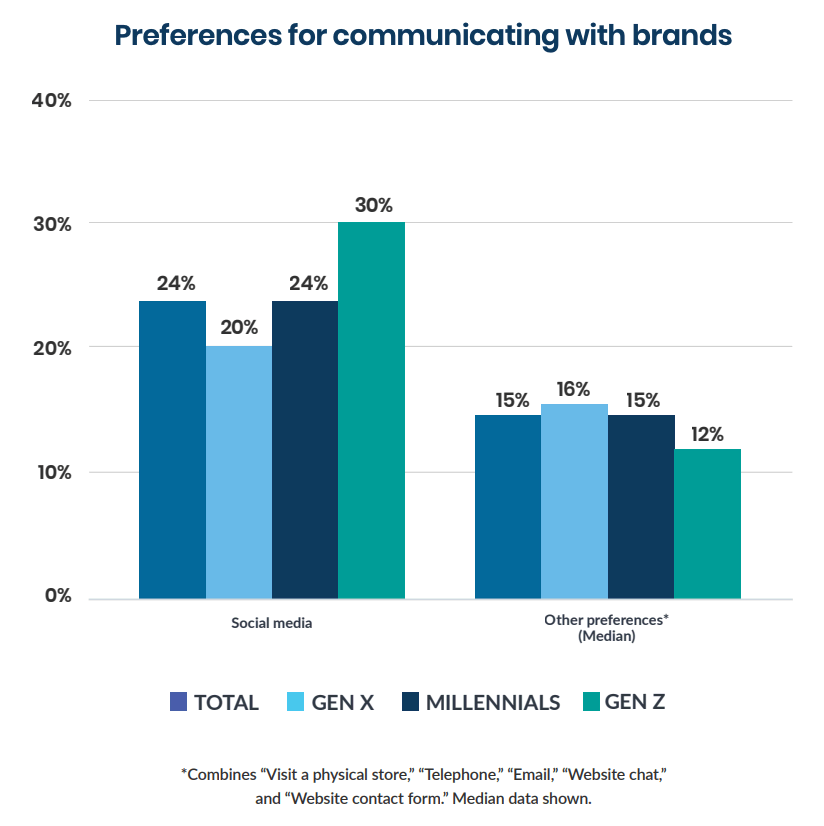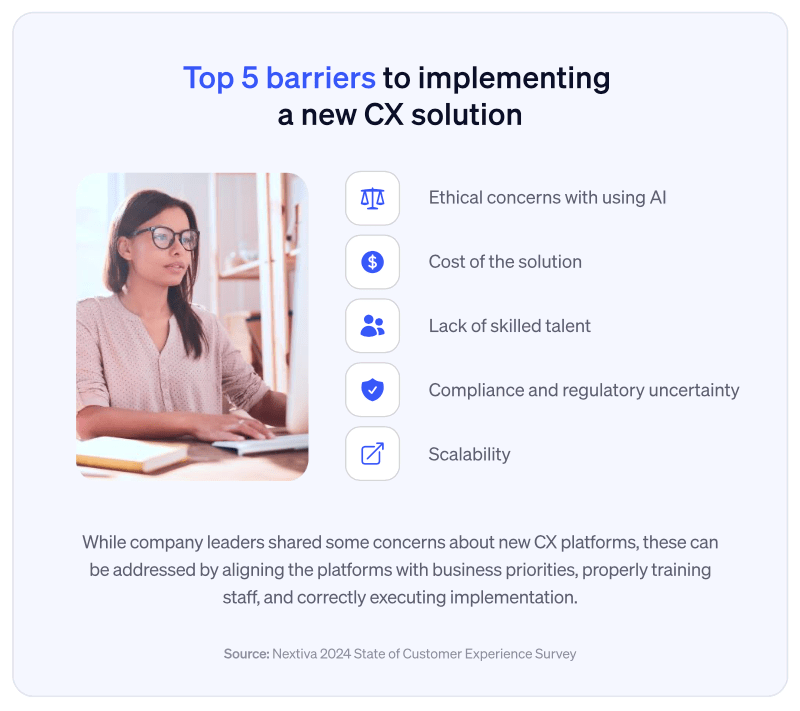Customers always remember how you make them feel.
This isn’t limited to one call with the sales team or a few interactions with the customer support department. This feeling envelops everything, from when present customers arrive as visitors to when they become your advocates.
It’s their whole experience with your brand. These customer experiences play a crucial role in fostering brand loyalty while also driving sales and revenue growth.
These customer experience insights will help you understand what works and what’s effective. Go through these statistics to deliver an exceptional customer experience (CX) to people associated with you.
Where does your CX strategy stand with AI?
Take the AI Maturity assessment to get personalized recommendations on how to enhance your CX.
Using AI To Offer Memorable CX
AI’s use is gradually increasing on the CX side. More and more customer interactions are being automated, assisting the customer service team in using their time more productively.
Customer service automation with chatbots has become the primary service channel for many of these teams, and their adoption is expected to rise over the next three years.
- Statistics show that 64% of business owners believe AI can improve customer relationships. Also, 80% of executives reported improved customer satisfaction and contact center performance with AI, making it a good investment on the CX side.
- When organizations incorporate AI, they see at least a 25% improvement in customer satisfaction, revenue, and costs.
- Chatbots will become the primary service channel for 25% of organizations by 2027, with 54% of support teams already using AI platforms.
- The conversational AI market is expected to grow 22% annually, reaching nearly $14 billion by 2025.
- Organizations linking customer satisfaction to growth and profitability are 29% more likely to secure larger CX budgets.
Utilizing Self-Service & Personalization To Improve CX
Most customers appreciate self-service options and personalization when agents, human or AI-powered, assist them. Personalization encourages customers to make purchases and become loyal customers.

- 49% of buyers make impulse purchases after a personalized experience.
- 67% prefer self-service over speaking to a representative.
- 91% would use an online knowledge base if available.
- 48% of consumers expect special treatment for being loyal customers.
- 74% of agents say more tools and customer data enable better personalization.
- 88% of online shoppers, including 96% of Gen Z and 97% of millennials, prefer personalized experiences.
- 90% of customers expect personalization in their interactions with brands.
- 59% of consumers expect businesses to use their data for personalization.
- 60% of consumers become repeat buyers after personalized experiences.
- 62% prefer personalized recommendations over general ones.
- 86% of B2B customers expect companies to know their personal information during interactions.
- Personalized service leads to 1.5 times higher customer loyalty.
The data shows modern customers expect personalization and seek self-service options when working with a company. These features are incredible value-adds in improving CX.
Related: How To Nail Customer Experience Personalization & Why It Matters
2025 State of CX Report
Get actionable insights to elevate your CX and fuel growth.
Resolving Issues With Speed & Efficiency
Every issue is a priority for a customer who’s struggling with it. Customers expect you to resolve their problems fast so they can keep advocating for your business. As a customer service team, you must proactively address customers’ concerns before they become a deal breaker for the company.
Resolving customer queries quickly and efficiently is crucial for transforming your brand’s CX from good to exceptional.
- Customers are 2.4 times more likely to stick with a brand when issues are resolved quickly.
- 81% of customers want proactive communication.
- 77% of buyers expect immediate engagement when approaching a company.
- 72% of businesses believe merging teams around CX will increase efficiency.
- 70% is the industry benchmark for resolving customer issues on the first contact.
Businesses that successfully offer quick responses see increased customer loyalty and spending.
Offering Omnichannel CX
Communication with customers takes place on different platforms. The chart below clearly shows diverse customer preferences when interacting with brands.

You can see that GenZs mostly use social media to reach out.
After GenZs, millennials are the next largest group of users to use social media platforms to voice their concerns. Let’s dive deeper into understanding how an omnichannel experience promotes a memorable CX.
- Only 7% of contact centers offering multiple service channels have achieved a seamless transition between different service channels, despite this being vital for customer satisfaction.
- 71% of customers use digital channels to connect for the first time in resolving customer queries.
- 16% of customers prefer contacting customer support over the phone when facing a general issue. This share increases to 29% when their problem becomes more complex and nuanced.
- 5% of customers use social media platforms to convey general issues. This number drops further to 3% when they’re facing complex problems.
- 42% of CX leaders report that generative AI will influence voice-based interactions in the next two years.
- 10% YOY growth and a 25% increase in close rates are experienced by companies with strong omnichannel strategies.
- 40% of consumers expect replies within an hour on social media and 79% within 24 hours, but only about 50% of businesses meet these standards.
- 53% of U.S. organizations use social media for customer service.
Keeping Customers’ Experiences Safe
Customers expect companies to save their data to add relevant personalization. However, this data raises a few privacy concerns. You must be transparent about managing customers’ data, increasing their trust in your business.
You must be responsible for keeping customers’ experiences safe within your organization. The chart below shows how companies of different sizes and locations take this responsibility.
- Over 95% of CX leaders invest in data integration, integrity, or enrichment.
- Around 74% of CX leaders have a detailed plan to counter digital deception and CX operation fraud.
- 78% of CX leaders agree that ignoring encryption in customer service exchanges can make customers’ data vulnerable.
- 54% of organizations struggle with fragmented data.
- 87% of customers won’t engage with an organization if they don’t have robust security.
Related: 14 Customer Experience Best Practices to Master CX
Measuring ROI From CX Investments
CX investments are positive for businesses as they deliver a decent ROI. They help you charge premium prices for your product or service while offering a competitive differentiator to many.
Take a look at these statistics to understand the ROI you can expect when you invest in CX.
- 86% of buyers are willing to pay more for a great experience.
- Over three years, investing in CX can add $700 million to $1 billion in revenue.
- The premium for luxury services can be up to 18% higher with excellent CX.
- 81% of organizations cite CX as a key competitive differentiator — however, only 44% plan to increase CX investments.
- 41% of customer-obsessed companies achieved at least 10% revenue growth last year, compared to 10% of less mature companies.
- Excelling at offering great CX increases sales at a rate up to 8% higher than the market average.
- 49% of customers who left a brand in the past year did so due to poor CX.
- 57% of leaders see a high ROI from chatbots.
- Fast-growing companies drive 40% more revenue from personalization than slower-growing counterparts.
- 60% of consumers choose one brand over another based on expected service.

Related: Must-Read Books to Improve Customer Experience
Driving Insights From B2B CX
The insights below will deliver key takeaways about what’s trending in the B2B space around CX.
- Improving CX decreases churn rates by 15% and win rates by 40%. This means that CX impacts a buyer’s journey before and after sales.
- CX leaders are more concerned about data protection and cybersecurity, with 83% of them seeing security as a top priority in their customer service strategies.
- The line between support and sales is beginning to blur. Around 80% of customers expect support representatives and chat agents to help them with everything.
- Companies plan to invest in CX tools and technologies that offer predictive instant experiences to customers in the upcoming year. Nearly 40% of companies with between 100 and 5000 employees plan to increase investment in predictive instant experiences in 2024 and 2025. This makes sense since 51% of customers prefer interacting with bots over humans when they need answers immediately.
- In companies with between 250 and 999 employees, 81% of CX leaders feel the need for AI transparency. Modern customers need more insights into automated decision-making.

Making Improvements Using CX Insights

As the lines between sales and support teams blur, you must bring both together to work toward a unifying goal of delivering exceptional CX. Using CX best practices to enhance the CX strategy.
Nextiva Contact Center manages customers’ journeys through sales and support departments. It brings all customer communication together, helping agents use context to guide their present and future interactions and deliver a memorable experience to customers.
Get the 2025 Leader’s Guide to CX Trends Now
This free 49-page report reveals actionable insights and strategies for CX success.
Stat sources

















 Customer Experience
Customer Experience 










